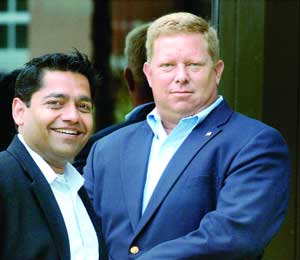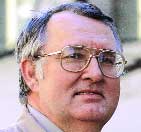When city officials in the nation's capital decided to build an interoperable wireless network for first responders, they adopted an approach that had barely been tested commercially, much less in government.Washington intends to install a high-speed, wireless, broadband data network capable of handling real-time voice, data and video ? the first citywide deployment of its kind for public safety, said Robert LeGrande, the district's deputy chief technology officer. There have been only three major commercial deployments of citywide wireless broadband services in the nation, he said. To get the extensive bandwidth to transmit data and video to first responders, the city got a special license from the Federal Communications Commission to use the 700-megahertz band. That Washington ? or any city ? would be ready to move to a high-speed data network for public safety was not something the federal government had envisioned, LeGrande said. For that reason, the city decided to fund the entire pilot out of its own pocket, he said. "We didn't have the time to wait for federal funds. The need was great for us to go forward," he said. "While we were able to apply for [federal] grants, there just wasn't the knowledge that this kind of network was even possible." In February, the district awarded a $3 million contract for a pilot to Motorola Inc. of Schaumburg, Ill., and its key subcontractor, Flarion Technologies Inc. of Bedminster, N.J. The initial installation will be finished this summer, and the network will be tested during the next 12 months, LeGrande said.Washington is not alone in its desire to improve first-responder communications. Federal, state and local governments will spend between $1.5 billion and $2 billion annually on interoperable wireless communications over the next few years, according to several industry estimates.Despite such spending potential, government and industry are still groping for the right approaches. The slow pace of federal funding, the need for greater regional cooperation and the lack of coordination among different levels of government have hampered progress, said Terry Kees, vice president of homeland security systems for Lockheed Martin Corp., Bethesda, Md. The wireless communications market "is coming together from a philosophical standpoint, but it ? will take a while for it to fully mature," Kees said.The upshot is that many new opportunities are pilot projects designed to test innovative concepts and solutions. Integrators vying for a toehold in this developing market are scouring the industry for new products and technologies, ranging from broadband and mesh network services to instant messaging and emergency management response systems.[IMGCAP(2)]Lockheed Martin Corp. and other integrators with expertise in public safety are partnering with companies eager to bring their first-responder products to market. "There's good technology coming out of the startups. The key is commercializing these technologies, so that those on the domestic battlefield can use them," said Jim Kaufman, vice president of homeland security for Ascentry Technologies Inc., a Tacoma, Wash., maker of wireless products.Desktop in the fieldIn Washington, city officials decided to adopt a broadband network with voice, data and imagery capabilities after a post-Sept. 11 evaluation revealed significant shortcomings in the city's communications systems. They tried to reconfigure the network, but it did not have sufficient bandwidth, LeGrande said. At the same time, Motorola was looking closely at companies providing broadband and mesh technologies, said Chuck Jackson, vice president and director for strategic services with Motorola's Americas Group. Among those Motorola evaluated were Arraycomm Inc. of San Jose, Calif.; Flarion; IPWireless Inc. of San Bruno, Calif.; MeshNetworks Inc. of Maitland, Fla.; Navini Networks Inc. of Richardson, Texas; and Tropos Networks Inc. of San Mateo, Calif. Motorola selected Flarion for the Washington pilot because the company's broadband solution fit well with the temporary FCC license the city got for the project, Jackson said. Flarion offers some of the best broadband service available, LeGrande said.The broadband pilot builds upon Motorola's recent upgrade of the city's public safety wireless radio system. As prime contractor on the broadband pilot, Motorola will provide installation, testing and operations for one year. The network will use 10 transmission sites to provide citywide coverage for first responders and transmit live images via Motorola's newly developed Greenhouse video-dispatch application. The new broadband network will let first responders use applications in the field that they normally must access from their desktop PCs, including video lineups and gang tracking software. It also offers real-time video to police, fire and emergency medical services en route to an incident, Jackson said. David Boyd, director of the Safecom program office in the Homeland Security Department, described the Washington project as well conceived and intelligent, saying it may yield some important lessons when it is completed. But Boyd, whose office is tasked with improving wireless communications among public safety organizations, said the project isn't right for everyone. "A good deal of the project is about the experimental FCC license, so it is not something that can be easily transported [from one jurisdiction to another]," he said. New projects, new partnersMajor urban areas such as Washington aren't the only ones looking to deploy wireless interoperable solutions for first responders. Many state and local regions are shopping for solutions and testing new products. In Eastern Massachusetts, for example, law enforcement officials in seven towns became concerned after Sept. 11 about the danger of a terrorist attack on a tanker transporting liquid natural gas in and out of nearby Boston Harbor. The cities formed the Eastern Massachusetts Seven City Coalition and bought 90 Hewlett-Packard iPaq handheld devices equipped with PocketCop software. [IMGCAP(3)]Developed by BIO-key Technologies Inc. of Minneapolis, PocketCop provides wireless communications capability, including e-mail and instant messaging, as well as access to federal and state criminal databases. The coalition spent $130,000, BIO-Key officials said. PocketCop gives police in the participating townships access to the Massachusetts Criminal Justice Information System, the FBI's National Crime Information Center and data repositories in other states via the National Law Enforcement Telecommunications System.BIO-key's Public Safety Group also provides PocketCop to the Massachusetts Law Enforcement Council and the Massachusetts State Police. All of the contracts leverage federal grants for homeland security. For its biometric and public safety solutions, BIO-key has partnered with AT&T Wireless Services Inc., ChoicePoint Inc., Hewlett-Packard Co., Itronics Inc., Northrop Grumman Corp., Oracle Corp., Saflink Corp. and Verizon Communications Inc. Other companies also are working with regional government consortiums eager to improve their first-responder capabilities. Evoxis Inc., a Pittsburgh startup, in March landed a four-year contract worth more than $500,000 for an emergency communications system for the Pennsylvania Southwest Emergency Response Group, an anti-terrorism consortium that includes Pittsburgh and surrounding counties.Evoxis' instant messaging software, Prodigent for Emergency Management, enables emergency and priority communications via e-mail, phones, pagers, personal digital assistants and other wireless devices. The consortium plans to use Prodigent for Emergency Management to coordinate regional activities of first responders in the event of a disaster. The system will be fully deployed later this month, said Mohan Ramani, Evoxis' chief executive officer. The company's messaging solution recently caught the eye of Alexandria, Va., systems integrator Gray Hawk Systems Inc. The two companies have formed an alliance to seek opportunities for emergency response in the state and local market, said Steve Komlo, Gray Hawk's vice president of information technology and telecom services. They are bidding five to 10 opportunities in the state and local market, he said. "We want to be able to lead state and local governments toward Homeland Security Department standards in emergency operations," Komlo said.Gray Hawk hopes to expand its presence in the state and local market by working with more companies such as Evoxis, Komlo said. "With the rapid changes in technology, you really have to be paying attention to capture a company like Evoxis," he said. "We are sensitive to companies that are bringing something new to the table."Staff writer William Welsh can be reached at wwelsh@postnewsweektech.com. XXXSPLITXXX-Even without a lot of money to throw around, the Homeland Security Department's Safecom program makes its influence felt, said David Boyd, Safecom's director.Safecom was created two years ago to address the wireless communications needs of public safety organizations at the federal, state and local levels. With an annual budget of only $22 million, Safecom cannot bankroll a large number of demonstration projects, but it works closely with all levels of government to establish standards and guidelines for developing interoperable voice and data systems. For example, after soliciting input from state and local stakeholders, Safecom in April issued a 192-page statement of requirements for interoperable wireless communications, Boyd said. The statement is intended to "put public safety officials in control of defining the requirements for interoperability, rather than having industry tell them what they need," he said. At the same time, the statement gives industry the requirements to meet state and local needs, rather than force them to guess what those requirements might be, he said.Safecom also works with the Justice Department's Community Oriented Policing Services (COPS) program and the Federal Emergency Management Agency to fund demonstration projects on two levels, Boyd said. On one level, Safecom will fund projects that test emerging technologies that facilitate communications interoperability, such as voice over IP and mesh networks. On another level, Safecom will help coordinate funding for patch-switching technologies that provide digital capabilities for legacy communications systems. COPS and FEMA have provided about $235 million for wireless interoperable communications in fiscal 2003 and fiscal 2004, Boyd said. Several regional wireless interoperability projects have been funded through these grants, he said. Homeland Security Secretary Tom Ridge announced that this year he will establish a new program office in the department that will be devoted to interoperability issues and initiatives, Boyd said. The new office will address first-responder interoperability issues related to communications, equipment and training, Boyd said. An initiative under way that will fall under the auspices of the new office focuses on planning and response to an emergency like the Sept. 11 attacks on the Twin Towers. This initiative, known as RapidCom9/30, is directed at 10 cities and regions the federal government has identified with the greatest risk of terrorist attack: Boston, Chicago, Houston, Jersey City, N.J., Los Angeles, Miami, New York, Philadelphia, San Francisco and Washington. A team from the National Guard, Homeland Security's Office of Domestic Preparedness and the Justice Department's Integrated Wireless Network is leading the project, Boyd said. The 10-city initiative involves technical assistance, planning sessions and equipment training, and will be completed by Sept. 30, he said. nXXXSPLITXXX-Despite a strong push by public safety agencies to include data with voice in new wireless projects, interoperable voice communication remains the top need of the nation's first responders."The public safety community has an absolute priority on voice. It also is interested in data and imagery but not at the cost of voice," said David Boyd, director for the Homeland Security Department's Safecom Program. When responding to an emergency, police, fire and emergency medical personnel are not in a position to read or type text, Boyd said. It is only after they arrive at the scene that they may have time to transmit or receive data.Voice interoperability is still the biggest business opportunity in public safety for Motorola Inc., said Chuck Jackson, vice president and director for strategic services with Schaumburg, Ill.-based Motorola's America's Group. With interoperable voice communications, personnel from different agencies can speak with each other by radio or cell phone. "Voice interoperability has been around a long time, so data interoperability has the buzz to it," Jackson said. "We talk more about data these days than we do voice, but mission-critical voice is clearly our biggest business."Adding interoperable data connections would let first responders send and receive text and messages via laptops or other wireless devices. Such connections, for example, would let them get building plans and other information crucial to rescue and evacuations. Motorola has a hard time getting customers to view data as mission critical, Jackson said. But this is gradually changing as law enforcement continues to adapt to its role in homeland security."Police departments are trying to get out of the reactionary mode and into the preventative mode. That's where data is taking on such an important role," he said.Jim Kaufman, vice president of homeland security for Ascentry Technologies Inc., Tacoma, Wash., agreed. He said data interoperability is increasingly important to homeland security, because data can give first responders a greater awareness of potential terrorist threats, something that is not always possible with voice interoperability. "Situational awareness is what is lacking in homeland security. Voice doesn't give situational awareness," he said.One thing data has in its favor is low cost. The advent of standards-based and Internet-based data communications has simplified designing and building an interoperable data network, said Kent Blossom, director of public safety for safety and security at IBM Global Services of Armonk, N.Y.A regional data interoperability project might cost about $10 million to $20 million ? or sometimes even less ? but statewide radio networks involving equipment upgrades and infrastructure replacement can cost hundreds of millions of dollars, industry experts said. Despite the costs, voice isn't going away anytime soon. Government wants industry to help it develop and deploy new technologies to achieve voice interoperability in the near term, Boyd said.The Safecom program aims to facilitate the demonstration of technologies that will help government reach voice interoperability. Some demonstrations will involve cutting-edge technologies; others will target more immediate improvements to existing systems."We must find ways to achieve near-term voice interoperability even with some very old technology as we create a migration strategy to achieve full interoperability with more solid technology," Boyd said. nXXXSPLITXXX-A sampling of companies looking to partner with systems integrators to deliver wireless, interoperable products and solutions for first responders. Each has one or more pilot or full-scale projects with a state and local customer. CEO: Federico PacquingHeadquarters:Tacoma, Wash.Founded: 20012003 revenue:$300,0002004 projected revenue: $5 million Employees: 24Business: A standards-based, wireless network platform that is deployable, self-healing and capable of self-configuration. Company provides networks that enable secure voice, video and data interoperability and collaboration using disparate devices. Partners: Northrop Grumman Corp., Telos Corp., WPCS International Inc., Fortress Technologies Inc., Symbol Technologies Inc., Sun Microsystems Inc. Projects: Deployed flexible nodes in intelligent transportation systems, including police, fire and emergency medical services for the Twin Cities/Minnesota Redundant Communications pilot.Web site: http://www.ascentry.com CEO: Mike DePasqualeHeadquarters: Minneapolis Founded: 1993 as SAC Technologies; renamed BIO-key in 20012003 revenue: $1.7 million2004 projected revenue: UnavailableEmployees: 35Business: Fingerprint-based biometric technology and mobile and wireless public safety solutionsPartners: Oracle Corp., Hewlett-Packard Co., Northrop Grumman Corp., Itronics Inc., Verizon Communications Inc., AT&T Wireless Services Inc., ChoicePoint Inc. and Saflink Corp. Projects: Provided software used in wireless devices to give law enforcement officials access to criminal databases, driver's licenses and fingerprint identification and authentication for the Eastern Massachusetts Seven City Coalition. Provided wireless access to criminal databases, automatic vehicle location and geographic positioning systems for Massachusetts State Police. Built a single communications infrastructure for the Northeast Massachusetts Law Enforcement Council, Eastern Massachusetts Seven City Coalition and Massachusetts State Police.Web site: http://www.bio-key.com CEO: Mohan RamaniHeadquarters: PittsburghFounded: 20012003 revenue: Unavailable 2004 projected revenue: $1.5 millionBusiness: Web-based software for intelligent messagingPartners: Gray Hawk Systems Inc., Positron Public Safety Systems Inc. and ICICI Infotech Inc. Projects: Implemented a communications system that provides detailed information to first responders through multiple communications channels for the Pennsylvania Southwest Emergency Response Group. Web site: http://www.evoxis.com Chairman and CEO: Ray DolanHeadquarters: Bedminster, N.J. Founded: 20002003 revenue: Unavailable2004 projected revenue: Unavailable Employees: 200Business: Provides mobile broadband systems that enable LAN-like communications in a cellular environmentPartners: Motorola Inc., Nextel Communications Inc. Wireless projects: Built a wireless broadband data network for Washington, D.C.Web site: http://www.flarion.com
Joe Ross (left) and Robert LeGrande, both with the District of Columbia's CTO office, helped lead an effort to install a high-speed, wireless network capable of handling real-time voice, data and video for the district's first responders.
J. Adam Fenster
Mohan Ramani of Evoxis and Steve Komlo of Gray Hawk Systems have found strength in numbers. Their companies formed an alliance to chase emergency response opportunities in the state and local market, Komlo said.
Laurie DeWitt
The wireless communications market "is coming together from a philosophical standpoint, but it ? will take a while for it to fully mature." | Terry Kees of Lockheed Martin
Rick Steele
Safecom issued requirements for interoperable wireless communications in April, said program director David Boyd.
Olivier Douliery
Standards-based and Internet-based data communications greatly simplified designing and building an interoperable data network, said Kent Blossom.
Olivier Douliery
 BIO-key International Inc.
BIO-key International Inc.  Evoxis Inc.
Evoxis Inc.  Flarion Technologies Inc.
Flarion Technologies Inc.











